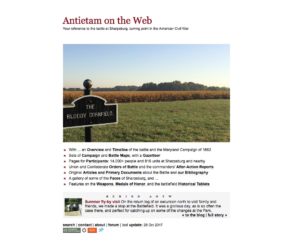Clickable, annotated Elliot burial map now on AotW
7 October 2020
In 1864, building on information collected by others, civil engineer Simon G. Elliott documented the locations of more than 5,800 soldiers’ burials on the battlefield of Antietam on a map. His similar work for burials at Gettysburg has long been known, but a copy of his Antietam map lay largely unnoticed in the New York Public library for many years until library staff digitized the map and made it available online between 2015 and 2018.
In June 2020 Gettysburg researchers Tim Smith and Andrew Dalton were looking into Elliott, came upon this map, and brought it to the attention of other historians and the public.
I’ve broken my digital copy into 14 large segments, each covering about 1/2 square mile of the battlefield, to make it a little easier for you to explore and make sense of this huge map. They’re all now up on Antietam on the Web (AotW) in a special exhibit.
49 individual soldiers and 32 regiments are identified on the big map. I have highlighted each of them in white and linked them to related pages on AotW so you can get more information about them.
This is Lieutenant Charles Frederick Williams, Jr. of the 35th Massachusetts Infantry. He was mortally wounded in action at Fox’s Gap on South Mountain on 14 September 1862 and died of wounds in Middletown, MD on 22 September.
His photo is from the Military Order of the Loyal Legion of the US, Massachusetts Commandery (MOLLUS-Mass) Civil War Photograph Collection, US Army Heritage and Education Center (USAHEC). The USAHEC, formerly the US Army Military History Institute (USAMHI) has hosted [gone in 2021] the excellent and massive MOLLUS Mass Collection online for at least 10 years (yay!), but they slapped this watermark over everything (boo).
Read more about the Collection history at Carlisle in a 2011 article by Molly Bompane.
____________________
update, 10 February 2021
Thanks to Heather Goyette in Ridgway Hall at USAHEC for the following instructions to find the MOLLUS images online:
The digital MOLLUS images … have been uploaded into our current Arena search page … You can then search … by entering the names of people, places, things, etc [in the search box]. As before, be sure to spell them out and not use abbreviations …
Clicking on the “Museum & Archives” tab near the top of the search results page will weed out library-related items …
To browse through individual album images enter “MOLLUS-Mass Civil War Photograph Collection” [in the search box] to see a listing of all digitized albums available, or enter something more specific such as “MOLLUS-Mass Civil War Photograph Collection Volume 4” to see what is available for an individual album. After selecting an album click on “Show linked records” to expand the list, and you can then click on individual image links to open them.
This new search interface will take some practice, but I’m so glad I can get the images again. And no sign of watermarks yet. Thanks USAHEC!
Below is Lt. Williams on page 4943 of Volume 96 of the Collection, with other officers of the regiment, from USAHEC.
Site Redesign Complete
20 February 2018
Antietam on the Web was a bit overdue for an overhaul: some of the PHP code had been deprecated (gone obsolete), much of the HTML was clumsy and likewise obsolete, and the site navigation didn’t make it easy to find the information on the site. Most of the navigation dated from 2005, and even the newest PHP and HTML code was last updated in 2010.
So I re-wrote and re-organized the whole thing.
The content is now gathered into big clusters for people (soldiers & units), places (maps), events (narrative), and features (special projects). I hope you’ll find it easier and more intuitive to use. It’ll certainly run more efficiently and be easier for me to maintain.
Here’s a quick visual comparison, new vs. previous home page design.
I’d love to hear how it works for you.





